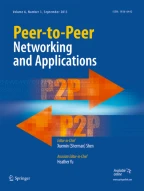Abstract
As the development of Internet of Things (IoT) technology has enabled various forms of intelligent services to be provided personalized intelligent services are provided for each person based on the data collected from IoT devices through P2P networking. Intelligent IoT services are gradually expanding. However, there can be various security risks in the devices that make up IoT networking. Untrusted devices can affect personalized IoT services by distorting personal information in analyzing the collected data. Therefore, services by the untrusted devices should be restricted. In this paper, the reliability is defined as the familiarity score, which is determined by the connection experience of the devices in a P2P IoT network. The IoT network composed of devices with high familiarity scores can be defined as a trusted area. In the trusted area, data generated by all devices is used to create knowledge for personalized intelligent services for users. In contrast, personalized intelligent services in untrusted area are restricted. Data generated by untrusted devices is classified by a learning algorithm such as logistic regression; thus, bad data is blocked by a gateway to avoid information distortion in data analysis for personalized intelligent services. The proposed method provides a trusted networking environment to IoT service users and protects data integrity. Thus, it can improve the user’s quality of experience (QoE) for personalized intelligent services. The proposed approach is evaluated by computer simulation and its superiority is validated.
Similar content being viewed by others
References
Atzori L, Iera A, Morabito G (2010) The internet of things: A survey. Comput Netw 54(15):2787–2805
Gubbi J, Buyya R, Marusic S, Palaniswami M (2013) Internet of things (IoT): A vision, architectural elements, and future directions. Futur Gener Comput Syst 29(7):1645–1660
Ali S, Qaisar SB, Saeed H, Khan MF, Naeem M, Anpalagan A (2015) Network challenges for cyber physical systems with tiny wireless devices: A case study on reliable pipeline condition monitoring. MDPI Sensors 15(4):7172–7205
Jing W, Miao Q, Chen G (2018) An open scheduling framework for QoS resource management in the internet of things. KSII Trans Internet Inf Syst 12(9):4103–4121
Al-Fuqaha A, Guizani M, Mohammadi M, aledhari M, Ayyash M (2015) Internet of things: A survey on enabling technologies, protocols, and applications. IEEE Commun Surv Tutorials 17(4):2347–2376
Kim SK, Sahu N, Preda M (2017) Beginning of a new standard: Internet of media things. KSII Trans Internet Inf Syst 11(11):5182–5199
Sinha RS, Wei Y, Hwang SH (2017) A survey on LPWA technology: LoRa and NB-IoT. ICT Express 3(1):14–21
Sohn I, Yoon SW, Lee SH (2018) Distributed scheduling using belief propagation for internet-of-things (IoT) networks. Peer-to-Peer Netw Appl 11(1):152–161
Beck MT, Werner M, Feld S, Schimper T (2014) Mobile edge computing: A taxonomy. In: Proc. of international conference on advances in future internet (AFIN), pp 48–54
Hu YC, Patel M, Sabella D, Sprecher N, Young V (2015) Mobile edge computing - a key technology towards 5G. ETSI White Paper (11)
Ahmed A, Ahmed E (2016) A survey on mobile edge computing. In: Proc of IEEE International Conference on Intelligent Systems and Control (ISCO)
Mach P, Becvar Z (2017) Mobile edge computing: A survey on architecture and computation offloading. IEEE Commun Surv Tutorials 19(3):1628–1656
Fan K, Wang J, Wang X, Li H, Yang Y (2018) Secure, efficient and revocable data sharing scheme for vehicular fogs. Peer-to-Peer Netw Appl 11(4):766–777
Kim DY, Kim S, Park JH (2017) Remote software update in trusted connection of long range IoT networking integrated with mobile edge cloud. IEEE Access 6:66831–66840. https://doi.org/10.1109/ACCESS.2017.2774239
Kim DY, Kim S, Park JH (2017) A combined network control approach for the edge cloud and LPWAN-based IoT services. Concurrency and Computation: Practice and Experience. https://doi.org/10.1002/cpe.4406
Sun X, Ansari N (2016) Edge IoT: Mobile edge computing for the internet of things. IEEE Commun Mag 54(12):22–29
Kim DY, Kim S, Hassan H, Park JH (2017) Adaptive data rate control in low power wide area networks for long range IoT service. J Comput Sci 22:171–178
D.Y. Kim, Y.S. Jeong, S. Kim, “Data-filtering system to avoid total data distortion in IoT networking. Symmetry Journal, Vol.9, No.1, ID 16, 2017
Lin Z, Xiao F, Sun Y, Ma Y, Xing CC, Huang J (2018) A secure encryption-based malware detection system. KSII Trans Internet Inf Syst 12(4):1799–1818
Alsheikh MA, Lin S, Niyato D, Tan HP (2014) Machine learning in wireless sensor networks: Algorithms, strategies, and applications. IEEE Commun Surv Tutorials 16(4):1996–2018
Di M, Joo EM (2007) A survey of machine learning in wireless sensor networks form networking and application perspectives. In: Proc of International Conference on Information, Communications & Signal Processing
Goodfellow I, Bengio Y, Courville A (2016) Deep learning. The MIT press, Cambridge
Kim S, Kim DY (2018) Efficient data-forwarding method in delay-tolerant P2P networking for IoT services. Peer-to-Peer Netw Appl 11(6):1176–1185
Tankard C (2015) The security issues of the internet of things. Computer Fraud & Security 2015(9):11–14
C.Y. Chen, M. Hasan, S. Mohan, “Securing real-time internet of things. arXiv preprint arXiv:1705.08489, pp.1-10, 2017, 2018
Ross SM (2002) Probability models for computer science. Harcourt/Academic Press, Orlando
Trivedi KS (2001) Probability and statistics with reliability, queuing and computer science applications. Wiley, Chichester
Acknowledgements
This research was supported by Basic Science Research Program through the National Research Foundation of Korea(NRF) funded by the Ministry of Education(NRF-2017R1D1A1B03032777), and this work was supported by the Soonchunhyang University Research Fund.
Author information
Authors and Affiliations
Corresponding author
Additional information
This article is part of the Topical Collection: Special Issue on P2P Computing for Intelligence of Things
Guest Editors: Sunmoon Jo, Jieun Lee, Jungsoo Han, and Supratip Ghose
Publisher’s note
Springer Nature remains neutral with regard to jurisdictional claims in published maps and institutional affiliations.
Rights and permissions
About this article
Cite this article
Kim, DY., Lee, A. & Kim, S. P2P computing for trusted networking of personalized IoT services. Peer-to-Peer Netw. Appl. 13, 601–609 (2020). https://doi.org/10.1007/s12083-019-00737-z
Received:
Accepted:
Published:
Issue Date:
DOI: https://doi.org/10.1007/s12083-019-00737-z
